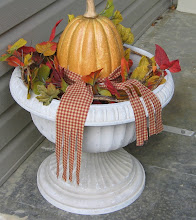
I've recently started collecting antique English Blue Willow china because I like the pattern. This platter was found at the thrift store for only 64 cents. But the story behind the painting is interesting, too.
Some versions of the Willow pattern have 3 people on the bridge, some only 2 or even 1. Most, but not all, have the 2 love birds. Usually, there is a willow tree, orange trees, a bridge with people, an island, a boat in the lake, a fence, and a tea house. Usually, but not always.
The borders might be different also. Some borders are decorated with butterflies and moths, some with fish eggs and some have a fleur-de-lis design. All love birds should be facing each other, but, their distance apart really is of no importance.
Here's the Chinese fable:
Once upon a time, a Chinese Mandarin of high degree lived in a Pagoda behind a strong fence and under the branches of a large orange tree. Nearby, a weeping willow hung over the river. This nobleman had a very beautiful daughter named Kong-Shee, whom he had promised in marriage to an old, but wealthy merchant, Tan-Jin.
The girl, however, had fallen in love with her Father's secretary, Chang, whom she met in secret and to whom she had sworn eternal fidelity.
When her Father discovered these meetings, he dismissed Chang from his service and threatened him with a lingering death, while he imprisoned his erring Daughter in her room overhanging the river until she should promise to forget her lover and marry the elderly merchant.
One day a coconut shell came floating past her window bearing a love letter from Chang. He mourned their fate and declared that life without her was worthless, and that if she married another he would commit suicide.
In her reply Kong-Shee proclaimed her devotion and told her lover that he must gather the fruit he coveted (herself) when the willow blossom was dropping on the bough. This hint gave him the approximate date of the wedding to the elderly man.
The wedding day arrived and Chang mingled among the numerous guests. He saw Kong-Shee and persuaded her to elope with him, but they were soon discovered, and as the pair were crossing the bridge her Father almost caught them.
Kong-Shee is carrying a distaff (emblem of her virginity), Chang a box containing hew jewels, and the pursuing father, a whip.

The lovers found a temporary hiding place in the small house at the end of the bridge, and signalled to the little boat on the water to take them to Changs home (in the upper portion of the design) but the angry father noticed them, and knocked at the door intending to beat them to death with his whip.
At this moment of danger, the Gods intervened to save the lovers, and changed them into turtle doves, which can be seen flying in company from the paternal vengeance. They lived happily ever after.

Two birds flying high,
A Chinese vessel, sailing by.
A bridge with three men, sometimes four,
A willow tree, hanging o'er.
A Chinese temple, there it stands,
Built upon the river sands.
An apple tree, with apples on,
A crooked fence to end my song.










.jpg)

































4 comments:
Oh! This is my new collection too! Inherited a complete set from my grandmother a few years ago, and am having the best time finding interesting pieces. Glad I found your blog - you might like mine too: http://www.everythingcoastal.blogspot.com - all about living at the beach
I love blue willow and also did a post on it at Nest by Tamara last summer.....I have been collecting it for many years and love that it is relatively inexpensive but with a rich history and great love story behind it. I love your blog, colors and inspirations. best, tamara
Now...there is china that has a story. Maybe I'll have a new collection to start also!
I love blue & white dinnerware pattern, It's so traditional and classic. It's a right option for you.
Blue Willow China
Post a Comment